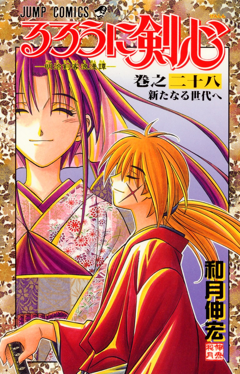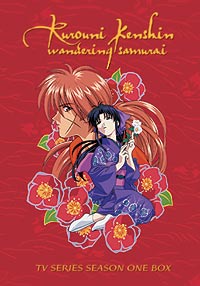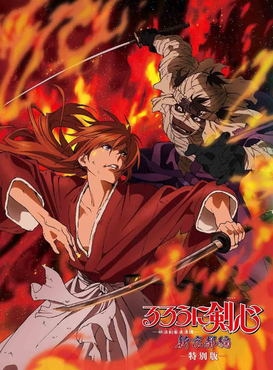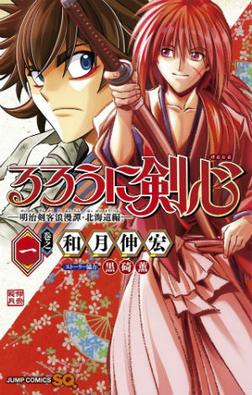The music of the 1996 anime television series Rurouni Kenshin was composed by Noriyuki Asakura. Four soundtrack albums were released. Two Songs albums, containing tracks performed by the Japanese voice actors, were also released.
The music of the 1996 anime television series Rurouni Kenshin was composed by Noriyuki Asakura. Four soundtrack albums were released. Two Songs albums, containing tracks performed by the Japanese voice actors, were also released.
Rurouni Kenshin -Meiji Kenkaku Roman Tan- The Original Soundtrack (るろうに剣心 –明治剣客浪漫譚–) was released on April 1, 1996. [1]
| No. | Title | Music | Length |
|---|---|---|---|
| 1. | "Overture - Kimi wa Dare wo Mamotte Iru (Strings Version)" (Overture - Who are You Protecting) | 2:22 | |
| 2. | "Opening Theme Sobakasu" (, Freckles) | Judy and Mary | 4:14 |
| 3. | "Kimi wa Dare wo Mamotte Iru (Original Mix)" (Who are You Protecting) | 2:42 | |
| 4. | "Himura Kenshin (Original Mix)" | 2:19 | |
| 5. | "Himura Kenshin (Gut Guitar Version)" | 2:29 | |
| 6. | "Hiten Mitsurugi ryu" (Kenshin's Battle Mode) | 2:12 | |
| 7. | "Tsuyoku Naritai (A Theme of Yahiko Myoujin)" (I Want to Get Stronger) | 1:16 | |
| 8. | "Aku Ichi Monji (A Theme of Sanosuke Sagara)" (One Word: Evil) | 1'40" | |
| 9. | "Kamiya Kashin ryu" (Kamiya Kashin's Battle Mode) | 1:55 | |
| 10. | "Kamiya Kaoru (Gut Guitar Version)" | 1:53 | |
| 11. | "Omoi: Odorenai Warutsu (Gut Guitar Version)" (Thoughts: Undanceable Waltz) | 1:11 | |
| 12. | "Aku no Ichi ~Shinji Rugayueni~ (A Theme of The Oniya Banshu)" (Evil One ~Reason to Believe~) | 1:30 | |
| 13. | "Aku no Ni ~Mou Hitotsu no Ishin~ (A Theme of Shishio)" (Evil Two ~One more Ishin~) | 1:13 | |
| 14. | "Aku no San ~Satsui no Uragawa~ (A Theme of The Dark Side of Your Heart)" (Evil Three ~The Other Side of Murderous Intent~) | 2:13 | |
| 15. | "Kamiya Dojo (A Theme of Kenshin's Family)" | 1:23 | |
| 16. | "Ayame to Suzume (A Theme of Kenshin's Family)" (Ayame and Suzume) | 1:35 | |
| 17. | "Gyuunabe de Paatto! (A theme of Akabeko)" (Celebrate with beef bowl!) | 1:24 | |
| 18. | "Demo ne! Honto wa ne!..." (But! Really!) | 1:17 | |
| 19. | "Kenjutsu Komachi (Kaoru's Theme)" (Sword Technique Beauty) | 2:13 | |
| 20. | "Kimi wa dare wo Mamotte Iru (Acoustic Version)" (Who are You Protecting) | 2:41 | |
| 21. | "Omoi: Odorenai Warutsu (Strings version)" ((Thoughts: Undanceable Waltz)) | 1:55 | |
| 22. | "Kamiya Kaoru (Kaoru's Love Theme - Original Mix)" | 2:15 | |
| 23. | "Kimi wa dare wo Mamotte Iru (Electric Guitar Version)" (Who are You Protecting) | 2:29 | |
| Total length: | 55:48 | ||
Rurouni Kenshin -Meiji Kenkaku Roman Tan- The Original Soundtrack II -DEPARTURE- (るろうに剣心 –明治剣客浪漫譚– オリジナル・サウンドトラック II —DEPARTURE—) was released on October 21, 1996. [2]
| No. | Title | Length |
|---|---|---|
| 1. | "Unmei no Hagaruma ~Kyoto e no Purorogu~" (「運命の歯車」~京都へのプロローグ~, Destiny's Wheels ~Prologue to going to Kyoto~) | 3:49 |
| 2. | "The Last Wolf Suite ~Shishio Makoto no Kumikyoku~ I. Cold Heart ~A theme of Soujirou~ II. The Land of Anger III. Juppon Gatana IV. Death Parade V. The Last Wolf ~A theme of Shishio Makoto~ VI. Red Rain VII. Chi no In (Red Stamp)" (「The Last Wolf Suite」~志々雄真実の組曲~, The Last Wolf Suite ~Shishio Makoto's groups music~) | 6:48 |
| 3. | "Hoeru Miburo ~A theme of Saitou Hajime~" (「蘇える壬生狼」—A theme of 斉藤 一—, Howling Wolf) | 2:17 |
| 4. | "Departure (Piano + Acoustic Guitar Version)" | 1:54 |
| 5. | "Nihon Meisou ~Ishin no Yami~" (「日本迷走」~維新の闇~, Japan Running Amok ~The Darkness of Ishin~) | 2:01 |
| 6. | "March of Ghost ~Bourei no Koushin~" (「March of Ghost」~亡霊の行進~, March of Ghost ~Ghosts walking~) | 1:41 |
| 7. | "Run to You ~A theme of Sagara Sanosuke~" (「Run To You」— A theme of 相楽左之助—) | 2:24 |
| 8. | "Frozen Flare - Shura no Fuuin-" (「Frozen Flare」—修羅の封印—, Frozen Flare -The Seal of No Feelings-) | 1:48 |
| 9. | "Welcome To My Nightmare -Youkoso, Akumu he-" (「Welcome To My Nightmare」—ようこそ、悪夢へ—, Welcome to My Nightmare -Welcome to My Nightmare-) | 1:06 |
| 10. | "Dancing with Devils -Saishuuheiki 1996-" (「Dancing with Devils」—最終兵器 1996—, Dancing with Devils -Last Weapon 1996-) | 2:52 |
| 11. | "Batousai Futatabi..." (「抜刀斎再び・・・」, (Batousai Again...)) | 1:20 |
| 12. | "[Starless] -Tsuki mo naku, Hoshi mo naku- (Acoustic Guitar Version)" (「Starless」—月も無く、星も無く— , Starless -No Moon, No Stars-) | 1:08 |
| 13. | "Departure (Master Mix)" | 5:10 |
| 14. | "[Starless] -Tsuki mo naku, Hoshi mo naku- (Master Mix)" (「Starless」—月も無く、星も無く—, Starless -No Moon, No Stars-) | 3:59 |
| 15. | "Kimi wa dare wo Mamotte Iru (Hard Version)" (「君は誰を守っている・・・」, Who are You Protecting) | 1:15 |
| Total length: | 39:50 | |
Rurouni Kenshin -Meiji Kenkaku Roman Tan- Original Soundtrack III -Kyoto Kessen- (るろうに剣心 –明治剣客浪漫譚– オリジナル・サウンドトラック III —京都決戦—, lit. Rurouni Kenshin: Romantic Tales of a Meiji Swordsman The Original Soundtrack III -Kyoto Decisive Battle-) was released on April 21, 1997. [3]
| No. | Title | Music | Length |
|---|---|---|---|
| 1. | "Hiten Mitsuryugiryu - Amakakeruryu no Hirameki - A theme of Hiko Seijunrou" (「飛天御剣流・天翔龍閃」—A theme of 比古清十郎—) | 4:25 | |
| 2. | "Fallen Angel -Haiiro no Tenshi-" (「Fallen Angel —灰色の天使—」, Grey Angel) | 6:03 | |
| 3. | "Kaoru to Misao I (Gut Guitar Version)" (「薫と操〈I〉」) | 1:32 | |
| 4. | "Ishin Tenpuku Keikaku" (「維新転覆計画」, The Ishin Overthrow Plan) | 4:56 | |
| 5. | "Sakura no Ki no Shita ni -Shisha no Shi-" (「桜の木の下に —死者の詩—」, Underneath the Cherry Blossom Tree - Poem of the Dead)) | 3:42 | |
| 6. | "Kaoru to Misao II (Pf Version)" (「薫と操〈II〉」) | 1:46 | |
| 7. | "Reppuu - A theme of Hiko" (「烈風」—a theme of 比古清十郎—, (Violent Wind)) | 1:16 | |
| 8. | "Oniwa Banshu - Kyoto Tansakugata" (「御庭番衆・京都探索方」, Oniwabanshu - Kyoto Investigation Team) | 3:08 | |
| 9. | "Warriors Blue - A theme of Shinomori Aoshi" (「Warriors Blue」—A theme of 四乃森蒼紫—) | 1:58 | |
| 10. | "Kaoru to Misao III (Full Mix Version)" (「薫と操〈III〉」) | 3:42 | |
| 11. | "Warriors Suite I. Retsuen II. Kako e no Ranbu (Wild Dance to the Past) III. TORAWARE (Captive) IV. Warriors" | 8:30 | |
| 12. | "NA-GO-MI" (「NA・GO・MI」, Peaceful) | 1:17 | |
| 13. | "Ending Theme [Heart of Sword ~ Yoake Mae]" (Ending Theme 「HEART OF SWORD ~夜明け前~」, Heart of Sword ~Before Dawn~) | T.M. Revolution | 4:01 |
| Total length: | 46:19 | ||
Rurouni Kenshin -Meiji Kenkaku Romantan- The Original Soundtrack IV –Let It Burn- (るろうに剣心 -明治剣客浪漫譚- オリジナル・サウンドトラックIV —Let It Burn—) Released February 1, 1998. [4]
| No. | Title | Length |
|---|---|---|
| 1. | "Welcome to my nightmare" (ウェルカム・トゥ・マイ・ナイトメア) | 4:39 |
| 2. | "Curved air" (カーヴド・エア) | 2:41 |
| 3. | "Dancing madly backwards" (ダンシング・マッドリー・バックワーズ) | 3:13 |
| 4. | "Lunatic" (ルナティック) | 4:30 |
| 5. | "Preacher" (プリーチャー) | 3:18 |
| 6. | "Justice" (ジャスティス) | 1:32 |
| 7. | "Let it burn" (レット・イット・バーン) | 5:11 |
| 8. | "Shades of cloud" (シェイズ・オブ・クラウド) | 2:27 |
| 9. | "Lightning" (ライトニング) | 5:39 |
| 10. | "Typhoon" (タイフーン) | 2:40 |
| 11. | "Let it rain" (レット・イット・レイン) | 1:30 |
| 12. | "Little wing" (リトル・ウィング) | 5:02 |
| Total length: | 41:54 | |
Rurouni Kenshin -Meiji Kenkaku Romantan- Songs (るろうに剣心 -明治剣客浪漫譚- SONGS) was released on August 1, 1996. [5]
| No. | Title | Music | Length |
|---|---|---|---|
| 1. | "Overture - Tsuioku - In The Past" (Remembrance ~In the Past~) | 4:28 | |
| 2. | "Kenshin Himura sings "Aisuru Hito Wo Mamoru Tame Ni"" (Kenshin Himura sings "In order to protect loved ones") | Suzukaze Mayo | 4:28 |
| 3. | "Kamiya Kaoru sings "Suki Toka Ja Nakute"" (Kamiya Kaoru sings "It's not that I Love...") | Fujitani Miki | 4:56 |
| 4. | "Sagara Sanosuki sings "Kokoro No Hadaka"" (Sagara Sanosuke sings "Naked Heart") | Ueda Yuji | 4:02 |
| 5. | "Miyoji Yahiko sings "Sekai No Boku"" (Miyoji Yahiko sings "World of Me") | Tominaga Miina | 4:29 |
| 6. | "Promenade - Over The Horizon" | 3:06 | |
| 7. | "Kenshin & Kaoru duet "Natsu No E"" (Kenshin & Kaoru duet "Picture of Summer") | Suzukaze Mayo & Fujitani Miki | 4:40 |
| 8. | "Sanosuke & Megumi duet "2 Of A Kind!"" | Ueda Yuji & Doi Mika | 4:08 |
| 9. | "Ayame & Suzume duet "Shiroi Ichigo"" (Ayame & Suzume duet "White Strawberry") | Yuasa Kaori & Namiki Noriko | 3:32 |
| 10. | "Rurouni Kenshin Voices sing "Kono Sekai No Katasumi De"" (At this small corner of the World) | ||
| 11. | "~Epilogue [Zanshou ~Venus and Mars~]" (Epilogue [Last rays of the sun ~Venus and Mars~]) | ||
| Total length: | 45:13 | ||
Rurouni Kenshin -Meiji Kenkaku Romantan- Songs 2 (るろうに剣心 –明治剣客浪漫譚– SONGS 2) was released on July 18, 1998. [6]
| No. | Title | Music | Length |
|---|---|---|---|
| 1. | "Innocence" | Seta Soujirou (Hidaka Noriko) | 4:31 |
| 2. | "Ice Blue Eyes" | Makimachi Misao (Sakurai Tomo) | 4:00 |
| 3. | "Ippatsu Yarou!" (一発野郎!) | Sagara Sanosuke (Ueda Yuji) | 3:25 |
| 4. | "Journey" | Seta Soujirou (Hidaka Noriko) | 4:33 |
| 5. | "Innocence (Drum'n' Bass Mix)" | Seta Soujirou (Hidaka Noriko) | 5:01 |
| 6. | "Kanashimi ni Tamesaretemo" (悲しみに試されても) | Amakusa Sayo | 4:11 |
| 7. | "Sonomama" (そのまま) | Katsu Itsuko | 4:02 |
| 8. | "The End of the Day" | Misanagi Moriya | 5:10 |
| 9. | "Ashita no Kakera" (明日のかけら) | Takatsuki Gentatsu (Sasaki Nozomu) | 5:18 |
| 10. | "Natsu no E ~'98 Summer Version~" (夏の絵, Picture of Summer) | Himura Kenshin (Mayo Suzukaze) & Kamiya Kaoru (Miki Fujitani) | 4:54 |

Rurouni Kenshin: Meiji Swordsman Romantic Story is a Japanese manga series written and illustrated by Nobuhiro Watsuki. The story begins in 1878, the 11th year of the Meiji era in Japan, and follows a former assassin of the Bakumatsu, known as Hitokiri Battosai. After his work against the bakufu, he becomes Himura Kenshin, a wandering swordsman who protects the people of Japan with a vow never to take another life. Watsuki wrote the series based on his desire to make a shōnen manga different from others being published at the time, with Kenshin being a former assassin and the story taking a more serious tone as it progressed.
Tetsuya Iwanaga is a Japanese voice actor.
Nobuhiro Nishiwaki, better known by his pen name Nobuhiro Watsuki, is a Japanese manga artist. He is best known for his samurai-themed series Rurouni Kenshin: Meiji Swordsman Romantic Story (1994–1999), which has over 70 million copies in circulation and a sequel he is currently creating, Rurouni Kenshin: The Hokkaido Arc (2017–present).
Kazuo Oga is an art director and background artist for many Madhouse Studio and Studio Ghibli anime films. Oga has worked with major directors Hayao Miyazaki, Isao Takahata, Yoshiaki Kawajiri, Osamu Dezaki. He also published two artbooks and directed a short animated film.

Rurouni Kenshin: Trust & Betrayal, known in Japan as Rurōni Kenshin -Meiji Kenkaku Rōman Tan- Tsuioku-hen, is an original video animation (OVA) series, based on the Rurouni Kenshin manga series by Nobuhiro Watsuki, and a prequel to the anime television series adaptation of the same name. Trust & Betrayal chronicles the story of Himura Kenshin as the Hitokiri Battōsai during the final years of the Bakumatsu era while also revealing the origins of his cross-shaped scar and exploring his relationship with a woman named Yukishiro Tomoe.

Rurouni Kenshin: Reflection, known in Japan as Rurōni Kenshin -Meiji Kenkaku Romantan- Seisōhen, is a Japanese original video animation (OVA) which serves as a sequel to the 1996 anime television series Rurouni Kenshin, an adaptation of the manga series of the same name by Nobuhiro Watsuki. It was animated by Studio Deen, directed by Kazuhiro Furuhashi and written by Reiko Yoshida. It was released from December 2001 to March 2002.
Akari Hibino is a Japanese voice actress best known for her role as the young Tsubasa Oozora in the soccer anime Captain Tsubasa. Other major roles include Konpoco in Esper Mami, Asa in Project A-Ko, and Shinji in Sonic Soldier Borgman. In Hunter × Hunter (1999) she voiced Feitan, and in Rurouni Kenshin, she voiced Okita Sōji, a major character in the Rurouni Kenshin: Trust & Betrayal OVA. She was married to Yōichi Takahashi, creator of Captain Tsubasa until 2015.

The first season of the 1996 Rurouni Kenshin anime television series is directed by Kazuhiro Furuhashi and produced by Aniplex and Fuji Television. The series premiered in Japan on Fuji Television and ran from January 10 to October 16, 1996. The episodes are based on the first six volumes of the manga series of the same name by Nobuhiro Watsuki. Situated during the early Meiji period in Japan, the story tells of a fictional assassin named Kenshin Himura, who becomes a wanderer to protect the people of Japan.

The second season of the 1996 Rurouni Kenshin anime television series is directed by Kazuhiro Furuhashi and produced by Aniplex and Fuji Television. The season ran in Japan on Fuji Television from October 30, 1996, to September 17, 1997. The season is based on volumes 7–18 of the manga series of the same name by Nobuhiro Watsuki, and depicts the fight of the former assassin named Kenshin Himura, against his successor Makoto Shishio, who aims to conquer Japan.

The following is a list of episodes 63–95 of the anime series Rurouni Kenshin, based on the manga series of the same name by Nobuhiro Watsuki. They aired in Japan, with the exception of episode 95, on Fuji TV from October 14, 1997, until the series concluded on October 15, 1998. Directed by Kazuhiro Furuhashi and produced by Aniplex and Fuji TV, the anime is set during the early Meiji period in Japan and follows the story of a fictional assassin named Himura Kenshin, who becomes a wanderer to protect the people of Japan. Unlike previous episodes, these were not adapted from the manga. During that period, the Jinchu Arc was still being written and one more final episode was missing by the end of the anime fillers. Studio Deen, who later animated the Trust & Betrayal, Reflections and New Kyoto Arc OVAs would replace Studio Gallop on animation production starting with episode 67.

Rurouni Kenshin: The Motion Picture, also known as Rurouni Kenshin: The Movie and Samurai X: The Motion Picture, is a Japanese animated martial arts film directed by Tsuji Hatsuki, produced by Katsunori Narumo and Akio Wakana and written by Yukiyoshi Ohashi. It is based on the Rurouni Kenshin manga by Nobuhiro Watsuki. Set in the Meiji Era, the plot follows the clashes between the two warriors, Himura Kenshin, a pacifist who wishes to stop a rebellion from Takimi Shigure and a band of desperate rebels who have sworn to settle one final score with society. The movie takes place somewhere after the Kyoto arc. It was released in Japanese theaters on December 20, 1997.

Rurouni Kenshin: Restoration is a Japanese manga series written and illustrated by Nobuhiro Watsuki. It is a retelling of his Rurouni Kenshin series, and served to promote the then upcoming live-action film released in August 2012. The manga was serialized in Shueisha's Jump Square from May 2012 to June 2013 and collected into two tankōbon volumes.

Rurouni Kenshin: New Kyoto Arc is a two-part original video animation (OVA) based on the manga series Rurouni Kenshin by Nobuhiro Watsuki. It is a retelling of the manga's Kyoto arc. Produced by Aniplex and animated by Studio Deen, it was released in December 2011 and June 2012. The story focuses on the young Oniwabanshu member Makimachi Misao, who encounters the protagonist, the wanderer Himura Kenshin, who is on a quest to defeat the forces of his hitokiri successor Shishio Makoto.

Rurouni Kenshin: The Hokkaido Arc is a Japanese manga series written and illustrated by Nobuhiro Watsuki. His wife, Kaworu Kurosaki, is credited as a story consultant. It is a direct sequel to Rurouni Kenshin and follows Himura Kenshin and his friends in 1883 Japan as they traverse Hokkaido in search of his father-in-law.

Rurouni Kenshin: Master of Flame is a two-chapter Japanese manga written and illustrated by Nobuhiro Watsuki. It is a spin-off of the main series Rurouni Kenshin. It tells the story about how Shishio Makoto met Komagata Yumi and formed the Juppongatana.

Rurouni Kenshin: The Beginning is a 2021 Japanese jidaigeki action film based on the Rurouni Kenshin manga series by Nobuhiro Watsuki. Written and directed by Keishi Ōtomo, it is the fifth and final installment of the Rurouni Kenshin film series and serves as a prequel, depicting Himura Kenshin's origins as the assassin "Hitokiri Battōsai", while exploring his relationship with the woman named Yukishiro Tomoe.

Rurouni Kenshin, sometimes called Samurai X, is a Japanese anime television series, based on the manga series of the same name by Nobuhiro Watsuki. It was directed by Kazuhiro Furuhashi, produced by SPE Visual Works and Fuji Television, and animated by Studio Gallop and Studio Deen. It was broadcast on Fuji TV from January 1996 to September 1998. Besides an animated feature film, three series of original video animations (OVAs) were also produced; the first adapts stories from the manga that were not featured in the anime series; the second is both a retelling and a sequel to the anime series; and the third was a reimagining of the second story arc of the series.

Rurouni Kenshin is a Japanese anime television series, based on the manga series of the same name by Nobuhiro Watsuki. It is the second anime television series adaptation after the 1996–98 series. Animated by Liden Films, the series' first season, which was directed and storyboarded by Hideyo Yamamoto, aired from July to December 2023 on Fuji TV's Noitamina programming block. A second season, subtitled Kyoto Disturbance and directed by Yuki Komada, premiered in October 2024.